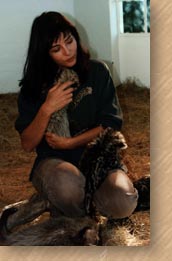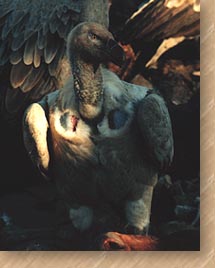|
October 1997 A trunk full of tender care 
In June, the Hoedspruit Research and Breeding Centre responded to a call for help. A two-month-old elephant calf had been found abandoned in mud in a mining area adjoining the Kruger National Park and a home that could provide a great deal of care was needed. The elephant calf was brought to the Centre and the struggle to raise the calf began. Elephant calves are notoriously difficult to raise as there is no proven milk formula, and the youngsters are extremely susceptible to diarrhoea. In addition, elephants have extremely close social bonds and require constant companionship. Many previous attempts by zoos and conservation centres have ended with the heart-breaking death of the youngster. At first it was touch and go, as the young calf experienced a great deal of stress. Dr Peter Rogers' first concern was to stabilise and improve the calfÆs condition.
A milk formula was recommended by Daphne Sheldrick who has had success with these gentle giants in Kenya. Skaap, the CentreÆs four legged foster mother was appointed to help Adri Crawford, the calfÆs human mother. Fanie assisted Adri with baby-sitting duties during the day. It was decided to name the calf Shabulani as he has already brought great joy to the staff at the Centre with his antics. During his daily walks in the veld around the Centre, he learns many skills which are necessary for survival, for example using his trunk to pick grass and leaves. However, he has also found a trunk to be useful for undoing shoe-laces and removing watch-straps.
 The glitz and the glamour
The glitz and the glamour
With a little help from my friend One of the most caring staff members at the Centre has four legs and a woolly coat. Skaap, a female sheep, was originally brought to the Centre as a companion for a sick rhino calf and has since proven to be worth more than her weight in gold by helping to raise rhinos, buffalo, a tsessebe and now Shabulani, the young elephant calf.Sheep are often used as companions for nervous or highly strung animals, as their placid nature proves to have a calming influence. This is especially important for young wild animals, who for a variety of reasons may have to be raised by humans. Often these young animals are sick or have been abandoned and are usually in a poor condition. Moving to a new environment can be extremely stressful and a sheep can provide comfort and help lessen the trauma. Skaap accompanies Shabulani on his daily walks and whenever Shabulani feels like a quick nap SkaapÆs back proves to be the perfect resting place. Skaap shares a special house with Shabulani ensuring her young charge is never alone during the night.
Flying Cheetah vs the Real Thing Ms Lente Roode and a cheetah cub recently posed in front of the Hoedspruit Air Force BaseÆs Cheetah Fighter Jet as a gesture of friendship. The Air Force Base and the Hoedspruit Centre share a mutual love of and respect for cheetahs and are both committed to nature conservation.
The Inn 
The HoedspruitCentreÆs Five Star Vulture Restaurant continues to serve choice cuisine to its feathered diners. which include the following five species of vulture: Cape griffins, whitebacked, hooded, whiteheaded and lappetfaced vultures. During the past four months the vultures were joined by a group of approximately twenty marabou storks whichspent most of the time savouring the culinary delights served by this sought after restaurant. The Centre ensures that any meat which is left over goes to good cause, supplementing the local vulturesÆ diet. By crushing bones the vultures also receive additional calcium necessary for the young chicksÆ bone development and strong egg shells. Recently most of the storks have moved on. However one female has decided to utilise the top of the ground hornbill aviary as a nesting site. The staff at the Centre are now anxiously awaiting the completion of the nest and the possibility of eggs being laid.
Four-legged Artists A gala dinner which will be held to raise funds for the ESPU Trust will receive an extra boost, when paintings done by various animals being cared for at the Centre, go under the auctioneerÆs hammer.Manya, an eighteen-month-old rhino calf, was a little wary of walking through the paint and onto the paper where her footprints would be preserved for prosperity. The elephant calf Shabulani and two three-month-old lion cubs, however, enjoyed the experience of lending a paw to create master pieces. The paintings will be framed and auctioned together with many other items donated by generous companies. All funds raised are for the ESPU Trust, which was founded to aid the Endangered Species Protection Unit of the Southern African Police Service with their task of protecting rare and endangered fauna and flora. The dinner will be attended by Prince Bernhard of the Netherlands who is the Patron of the Trust. Prince Bernhard will be spending time at the luxurious Kapama Lodge and will have the opportunity to visit the Hoedspruit Research and Breeding Centre.
The Hoedspruit Research and Breeding Centre
for Endangered Species
|
| If you have no navigation at the top of the page, go HERE. Brought to you by www.wildnetafrica.com © WildNet Africa (Pty.) Ltd. - Africa's Wildest Web Disclaimer: the information on this page is used entirely at the reader's discretion, and is made available on the express condition that no liability, expressed or implied, is accepted by WildNet Africa or any of its associates, employees or subsidiaries for the accuracy, content or use thereof. |

 Cheetah
Chat
Cheetah
Chat
